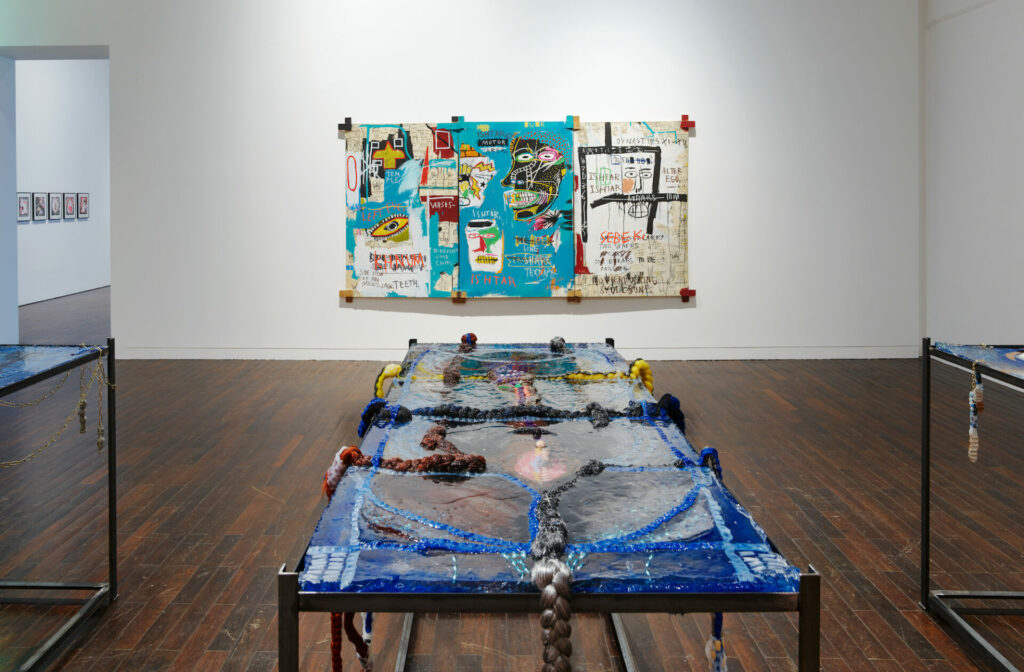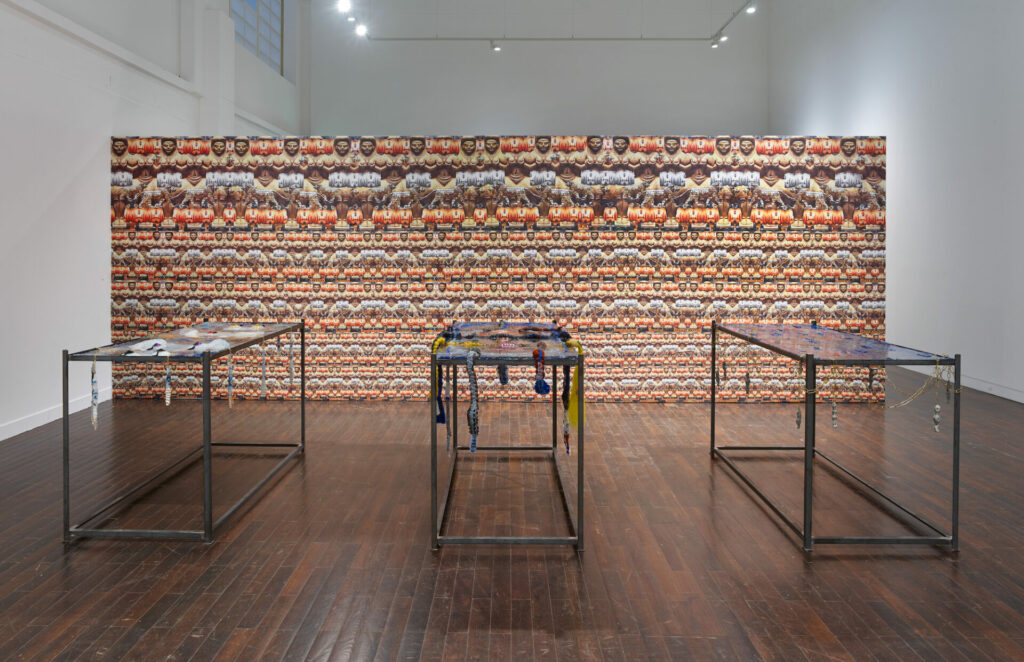Jean-Michel Basquiat
* 1960 in New York City (NY), USA
† 1988 ibid

Basquiat’s Ishtar brings together all the characteristics of his oeuvre: The rhythmic use of text in the image, the layered structure in terms of form and content, the collage-like composition of the materials used, and his core themes of Racism, society, art theory, and literature, which are expressed here through dualisms. He himself said, “I don’t think about art while I work. I try to think about life.” It comes as little surprise, then, that the artist turns out to be a subtle observer of current discourses and living conditions in 1970s and 1980s New York, which have lost none of their relevance to this day.
On the central panel of the triptych, Ishtar shows a White and a Black portrait with the repeated inscriptions ISHTAR. They identify both portraits as the most important Mesopotamian deity. For Ishtar is characterized by the fact that supposedly opposites are united with each other: Thus, the deity can appear as a man and as a woman, is thus genderqueer according to today’s understanding. In addition, he*she is simultaneously considered the deity of love, beauty and fertility as well as of war, anger and revenge. In addition, Basquiat draws on various ancient mythologies, which he continues with the inscriptions KHNUM on the left and SEBEK on the right panel – names of ancient Egyptian gods – which refer to Ishtar through their connotation and the flanking of the middle panel. Thus Khnum was considered the god of creation, while Sebek, usually depicted as a crocodile, stood for fertility. What is striking is Basquiat’s deliberate recourse not to Roman or Greek mythology, but to mythologies of the African continent and the Near East. In this way, he specifically draws attention to BIPoC cultural assets.
Even though the artist never explicitly names racism in his works, he repeatedly counteracts it by drawing attention to black achievements, for example. Furthermore, he reflects on how historically grown power imbalances still have an effect in the present. In this context, the inscription SIDE VIEW OF AN OXEN’S JAW is significant, referring to the Old Testament figure of Samson. With the help of a jawbone from a donkey, he is said to have slain 1,000 Philistines who wanted to hold him captive (Ri 15:15-16). Is this a criticism of Christian imperialism in the course of Colonialism? Additional inscriptions such as DYNASTIES, TEMPLE, REVELATION, or ALTER EGO show Basquiat’s engagement with ancient materials and his self-placement.
At the same time, Basquiat makes use of a complex semiotic system, which he developed within the framework of his visual language and which he himself describes as facts, which he borrowed from everyday culture and also drew from literature and historical sources. Copyright signs, for example, which can be understood as a critique of consumption, appear again and again. The use of whole words is intended to specifically link the pictorial theme with topics and events in a dimension outside the defined pictorial space. Great importance is also attached to the crossing out of individual words, for Basquiat thus deliberately attempts to draw the attention of viewers to their decoding.
The artist uses superheroes such as Captain America, which he borrowed from comics, as contemporary incarnations of ancient and biblical figures. They are attached to the painting support as collages on photocopies. In this way, they obscure parts of the painting. Thus, even on a formal level, a multifaceted construct emerges that approximates the construction of personal and collective Identities. This accumulation of various associations weaves itself into an encyclopedic web that must be individually deciphered and thought through by viewers. This makes it clear that Basquiat’s work renounces any form of unambiguous Categorization. Rather, his mind-map-like works critically question social structures in their interplay between historical and contemporary reality.
in dialogue with

Theresa Weber
Ishtar Altar / Ishtar Wall Paper, 2021
